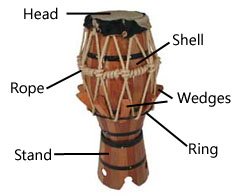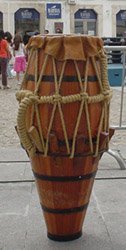|
AtabaqueThe first time I noticed the atabaque in capoeira was hearing its beat in the roda. It was keeping the pace of the game. It’s the major drum used in the bateria (music line up) and thus supplies the base beat in capoeira music. As I started to learn more about the drum, I’ve discovered how complex it and its history are… Significance of the Drum
Within capoeira, the berimbau, pandeiro and this drum are the chief instruments of the roda. They provide the music for the capoeiristas to play to. The atabaque specifically keeps the beat of the rhythm provided by the berimbau. The drum wasn’t always just the support for the berimbau in the bateria though. I learned from my mestre that it was most likely the first instrument that capoeira was played to. The drums were an integral part of the African culture and it makes sense that they’d provide the initial beat for the original game. The atabaque is also used in other areas of Brazilian culture. Maculele is a dance and performance where the atabaques are heavily used to provide the beat for the dancers. Another area of their use is in candomble. Candomble is an Afro-brazilian religion that is mainly practiced in Brazil. Here it is seen as a sacred instrument that receives a lot of respect. Simply put, this drum is used in a lot of unique ways. This is mirrored in all of its unique parts… Parts of the Atabaque
Just by looking at it, you can tell the atabaque is special, both in its uniqueness and creation. I couldn’t tell why it had rope and wedges on it; I thought it was for decoration… As I discovered, each part of the instrument has a purpose. Below I’ll go into more detail on each part. 
That covers the basics of the drum. Now for the fun part, playing it! How to PlayWithin capoeira, I’ve only learned the bare-bone basics of playing this drum. So far I’ve only used two notes to play the rhythms used in the roda. These notes are…
Using these two strikes, we play a couple of rhythms in capoeira. Here are the two I know.
Where to Buy
Return from Atabaque to Capoeira Instruments
|



